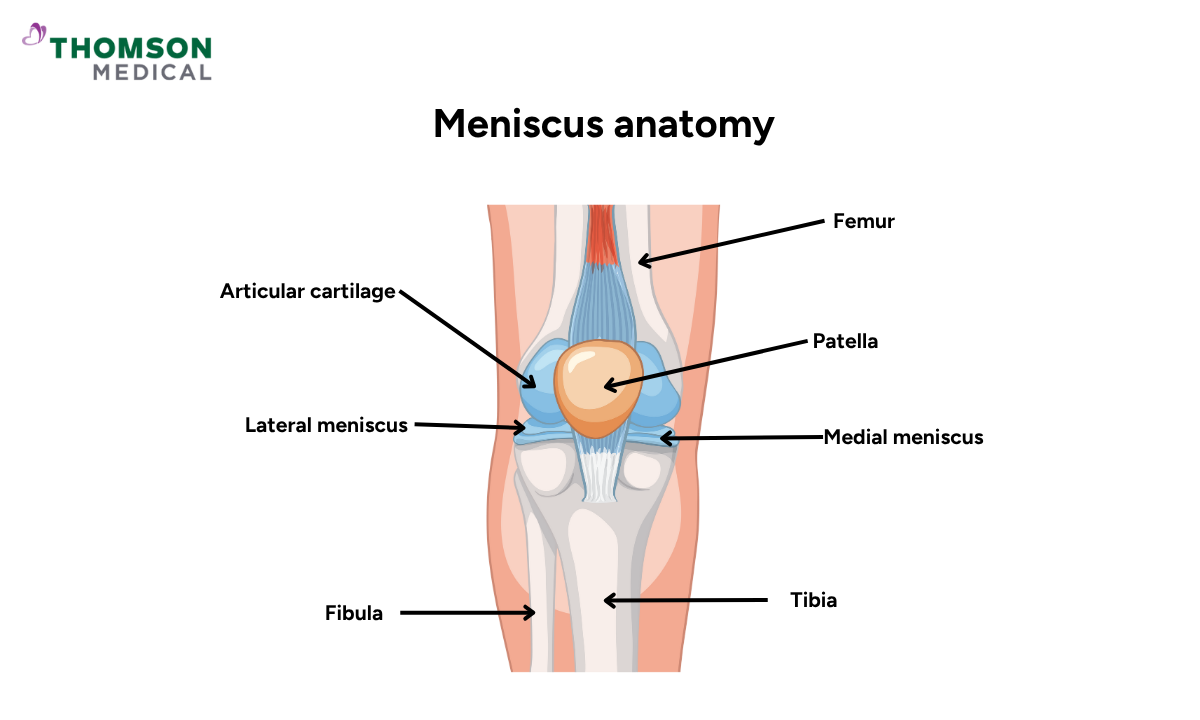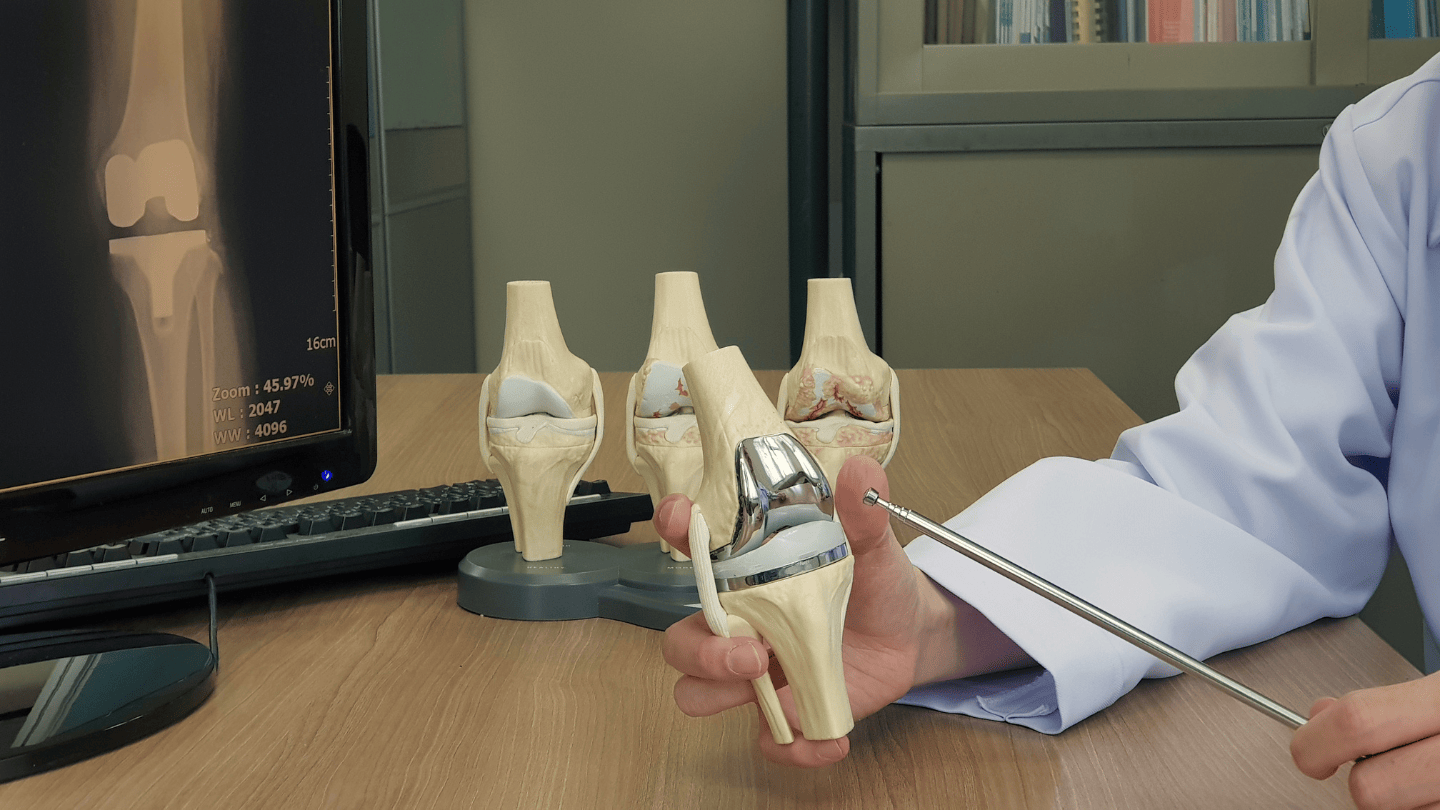If you have a meniscus tear, your healthcare provider may recommend conservative treatments, such as resting your leg, applying ice, and undergoing physical therapy at first. Yet, even with these measures, you might still experience pain, swelling, stiffness, reduced range of motion, or instability in your knee.
If your symptoms persist, your doctor may suggest meniscus surgery, depending on the tear's size, type, and location. However, depending on the type of surgery performed, you may require a knee replacement in the future to ensure long-term knee health.
What is a meniscus surgery?

Meniscus surgery is a medical procedure used to treat a torn meniscus. The meniscus is a C-shaped piece of cartilage that acts as a shock absorber between the thigh and shin bones, cushioning your knee joints when you walk, run, or jump. The aim of the surgery is to relieve pain, restore knee stability and mobility, and prevent further joint damage.
Before the procedure, your doctor will confirm that you are fit for surgery. As this is an arthroscopic surgery, it is minimally invasive, and only a few small incisions are required. The procedure usually takes about an hour, and general anaesthesia is typically administered beforehand.
Why do I need meniscus surgery?
Your doctor may recommend meniscus surgery if:
You have a serious meniscal tear
You experience persistent knee instability, locking, or ongoing pain and swelling
Your symptoms have not improved with conservative treatment, such as rest, ice, medication, or physical therapy
Types of meniscus surgery
There are three main types of meniscus surgery:
Partial or total meniscectomy:
In a partial meniscectomy, your doctor removes only the damaged part of the meniscal tear, preserving as much healthy tissue as possible.
However, if there is too much damage to the cartilage, your doctor will remove the entire meniscus. Such removal can increase the risk of developing arthritis in the knee over time.
Meniscus repair:
During this procedure, your doctor will stitch the meniscus tear back together and repair any other damages to the meniscus. The stitches will encourage the meniscus to heal back into one piece, and your body will absorb them as the tear heals.
Meniscus repair is preferred, as it helps to preserve knee function and reduces the risk of osteoarthritis compared to a meniscectomy. However, not all types of meniscal tears are suitable for repair.
Meniscus transplant:
Meniscus transplants are less common and are usually considered for younger and more physically active patients who have undergone a total meniscectomy and are still experiencing symptoms.
The procedure involves replacing the damaged meniscus with a donor meniscus.
What is knee replacement surgery?

A knee replacement surgery is a surgical procedure where damaged cartilage and bone in your knee joint are replaced with prosthetic components to relieve pain and restore function. There are two types of this surgery:
Total knee replacement:
In a total knee replacement procedure, all of your damaged cartilage and knee joint are replaced with prosthetics.
Partial knee replacement:
During a partial knee replacement procedure, only the damaged cartilage, whether medial (inner), lateral (outer) or patellofemoral (front), is replaced.
Why do I need a knee replacement?
Your doctor may recommend this procedure if you experience any of the following symptoms:
Hear popping sounds coming from your knee joint when you move it.
Feel severe knee pain while walking, resting, or performing daily activities.
You have tried non-surgical treatments, such as medication or physical therapy, but they no longer provide relief.
Have a severely torn meniscus that cannot be repaired and is causing ongoing pain and loss of knee function.
Have any significant injuries to your knee cartilage due to arthritis, such as osteoarthritis or rheumatoid arthritis.
Does meniscus surgery lead to knee replacement?
The type of arthroscopic surgery you have received can affect your chance of needing a knee replacement procedure in the future. This is especially the case after a meniscectomy, as the removal of the meniscus cartilage increases stress and friction in your knee joint and reduces shock absorption.
Over time, your knee bones may rub against each other, resulting in osteoarthritis. This degenerative knee condition can cause inflammation of the knee joints, leading to symptoms such as pain, swelling, and restricted movement.
However, if there is severe cartilage degeneration in your knee, a knee replacement will be required regardless of whether you have had meniscus surgery. On the other hand, if the meniscus tear is not serious and you undergo meniscus repair surgery alongside proper recovery and rehabilitation, you might not require a knee replacement.
If you have a meniscus tear, your doctor will recommend the most appropriate treatment based on the type and location of your tear, your age, and your activity level. Schedule an appointment with Thomson Medical to find out more about arthroscopic knee surgery or a knee replacement surgery and its suitability for your condition.
Alternatives to meniscus surgery
To reduce the need for knee replacement surgery in the future, it is recommended that you consider non-surgical treatments for meniscus tear first. This is because the meniscus keeps the knee joint stable, helps to distribute the weight on the joint evenly, and prevents the bones from rubbing against each other.
However, we recommend an arthroscopic knee surgery if conservative treatments fail to improve your condition. So, before jumping to surgical options, here are some alternative treatments to consider before undergoing knee replacement surgery:
Physical therapy:
Physical therapy is an exercise program designed to strengthen the muscles around your knee, helping support and stabilise the joint. This can also reduce pain and improve mobility.
Low-impact exercises such as cycling on a stationary bike, hydrotherapy, walking in a pool, and swimming are often recommended.
Medications:
Nonsteroidal anti-inflammatory medications (NSAIDs), such as ibuprofen or naproxen, can aid with pain and swelling. In some circumstances, your doctor can also prescribe corticosteroids for temporary relief.
Joint injections:
To help relieve knee pain, your doctor may perform an injection of cortisone to reduce inflammation or hyaluronic acid to improve joint lubrication.
In certain cases, regenerative treatments such as platelet-rich plasma therapy may also be considered, as these may help promote the growth of cartilage and support joint recovery.
Knee unloader brace:
A knee unloader brace can assist in reducing pressure on the damaged knee, particularly if you have osteoarthritis. These braces can help with pain and movement by moving weight away from the injured area.
Maintain an ideal body weight:
Maintaining a healthy weight alleviates stress on the knee joints, reducing discomfort and slowing joint deterioration.
FAQ
Do I need a knee replacement if I have a torn meniscus?
Not necessarily. Many meniscus tears can be successfully managed with nonsurgical treatments, such as physiotherapy, medication and lifestyle changes.
Most people with meniscus tears do not require a knee replacement, particularly if they have minimal arthritis and adhere to the recommended treatment plan.
How long after meniscus surgery might a knee replacement be needed?
The timing varies considerably. Research shows that, within five years of arthroscopic knee operations, around 10% of patients may require a knee replacement, compared to just 2% of patients who undergo physical therapy alone.
Some people with significant cartilage damage or arthritis may need a knee replacement within five to ten years, while others may never require one.
Are there ways to reduce the risk of needing a knee replacement after meniscus surgery?
Yes, you can help protect your knees by:
- Maintaining a healthy weight to reduce joint stress
- Avoiding high-impact activities that put stress on the knee
- Managing osteoarthritis early with appropriate medical care
- Considering non-surgical treatments before deciding on surgery
- Adhering to a tailored therapy after surgery designed by your physical therapist
Does meniscus surgery weaken your knee?
Over time, meniscectomy can reduce your knee's natural shock absorption, as removing meniscus tissue decreases the joint's cushioning and support.
This can lead to increased stress on the remaining cartilage and a higher risk of developing osteoarthritis. When feasible, meniscus repair preserves more of the joint's natural mechanics and function.
Will my knee ever be the same after meniscus surgery?
With meniscus repair surgery and proper rehabilitation, your knee can return to close to normal function. Most patients experience a significant reduction in pain and an improvement in stability.
However, some people may experience mild knee stiffness or slight changes in knee mechanics. Once fully healed, your knee will likely be stronger and more stable than before surgery.
The time it takes to recover varies depending on the type of surgery; meniscectomy typically allows a faster return to normal activities, whereas meniscal repair takes longer but preserves more natural knee function.
What should I discuss with my surgeon before deciding on meniscus surgery?
Before making your decision, make sure you discuss the following key points with your surgeon:
- Treatment options:
- Ask whether surgery is your only option, since many meniscus tears can be managed with non-surgical treatments, such as physical therapy or joint injections.
- Type of surgery recommended:
- Understand why your surgeon is recommending either a meniscectomy (removal of torn tissue) or a meniscus repair (stitching the tear), as each procedure has different benefits, risks, and recovery times.
- Long-term outcomes:
- Be aware that meniscus surgery, particularly meniscectomy, can increase your risk of developing knee arthritis in the future. Ask whether the procedure will help prevent future knee problems or if it might contribute to them.
- Recovery period:
- Ask about the expected recovery process after surgery before returning to daily activities, work, or sports, as this varies significantly depending on the type of surgery.
This information is intended as general guidance only and should not be considered as medical advice. For personalised health screening recommendations based on your medical conditions, schedule an appointment with Thomson Medical.
For more information, contact us:
Thomson Specialists (Thomson Medical Centre) — Orthopaedic
Request an Appointment